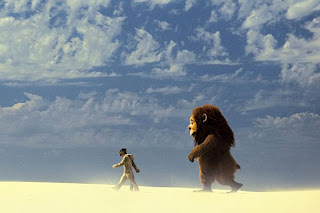[Article originally appeared: : http://www.westviewnews.org/cms/index.php?option=com_content&view=article&id=708:top-five-favorite-film-moments-of-2009&catid=43:articles&Itemid=170]
Where the Wild Things Are
The children’s book “Where The While Things Are” came out the year I was born, 1963. Growing up in the 60s and 70s, this was the seminal book of my childhood. I have such vivid memories of it. When I recently picked up a new copy of it and read it to my own five-year-old son, it felt as though no time had passed since I had last looked through its pages. Even though it’s the sparest of stories, Maurice Sendak’s illustrations are so potent, so powerful, that the story not only comes to life but seems epic somehow. Spike Jonze’s adaptation, fully endorsed by the author, expands greatly on the book. A good adaptation ought not be too dedicated to the original source but rather take the essence of the story, find the soul, and express it through the visual media. In order to put “Wild Things” on the screen, Jonze and Dave Eggers, who co-wrote the screenplay, went deep into his hero’s anguish and came up with a cathartic and beautiful story about a boy, Max, who is terrified of abandonment. His solution is to create a world of monsters where he is the king. The monsters are grizzly, smelly and full of bombast but also insecure to their core. Like Max, all they want is a someone who will love them and take care of them. In the meantime, sleeping in a pile will have to do.
Every Little Step
A Chorus Line will forever remain the most important musical I’ve ever had the good fortune to see. I remember going to a matinee performance at the Public Theater in the late summer of 1975. My parents were members of the Public and, thank God, they took me and my sister along to see this edgy new musical which depicted the lives of Broadway chorus dancers in a language and raw physicality that had never been presented before. The production would soon go to Broadway and change the very definition of what a Broadway musical could be. This documentary, “Every Little Step”, centers on the casting of the 2008 revival. Through the process of auditioning a new cast, the documentary becomes a mirror image of the play. The original creators who are involved in casting the revival are desperately searching for those rare performers who can embody the characters created by the late Michael Bennett, whose absence is felt in every moment of this moving documentary.
Anvil: The Story of Anvil
There’s a moment of pure desperation when guitarist and singer Steve ‘Lips’ Kudlow apologizes to his drummer and best friend, Robb Reiner. In the studio working on their latest album, and possibly their last shot at a comeback, exhausted from days of marathon recording, the two have a another in a long line of break-ups. Reiner walks out swearing that he’s through with the band and Kudlow declares that the band will be just fine without the drummer. The moment is quintessential Spinal Tap, only in this case it’s the real deal. A little later, after the two have cooled off, Kudlow admits that their band, Anvil, and all their years of trying to sustain it, mean nothing without his best friend and spiritual brother by his side. Fighting back tears, Kudlow confesses that what he and Reiner share and have shared is all he’s got. The confession is stunning and every documentary maker’s money shot. This is the story of a washed-up Canadian metal band whose shining moment may have passed but whose members’ humanity still shines on rather brilliantly. This one goes to twelve.
District 9
There’s this one unforgettable episode of the 1970’s sitcom, “All In the Family”, where Archie Bunker is informed that he’s just had a blood transfusion donated by a person of color. He’s thrown into utter confusion and dismay but later, realizing he has almost joined a white supremacist group, he declares that he and his black brothers will stand together. Similarly, in director Neill Blomkamp’s film “District 9”, the anti-hero (Sharlto Copley) goes through a similar identity shift after he too receives an unexpected transfusion, only this time from an alien refugee. Because the story takes place in Apartheid-era South Africa, the comparison to the sitcom episode is fairly apt. Watching the conditions of the alien refugee camp, one is reminded of the living conditions in New Orleans those weeks and months after Katrina. But have no fear, this movie absolutely delivers on comedy and action; you’ve never seen science fiction that looks like this.
 Precious: Based on the Novel ‘Push’ by Sapphire
Precious: Based on the Novel ‘Push’ by Sapphire
I will always remember Mo’Nique’s raw performance in this otherwise traditionally structured film. The moment when she breaks down in the social worker’s office is a place few actors go. Moments later when Clareece ‘Precious’ Jones tells the social worker, played by a make-up free Mariah Carey, that she is in over her head, she could be talking to the singer/actress as well. It’s really not fair to compare Mo’Nique’s performance to Mariah’s or, for that matter, to any other actresses in last year’s line-up of movies. To predict that she will be nominated for an Oscar would be like having predicted the 2008 presidential election. Come on! She’s a shoo-in to win Best Supporting Actress. Despite the latter-day endorsements of executive producers Oprah Winfrey and Tyler Perry, this is a movie that was bound to cause controversy in its depiction of an obese 16-year-old girl pregnant for the second time by her recently deceased father. Despite its lapses into melodrama, it is a reflection of where we are in the Obama-age that a movie like Precious has made it to the multiplex.


